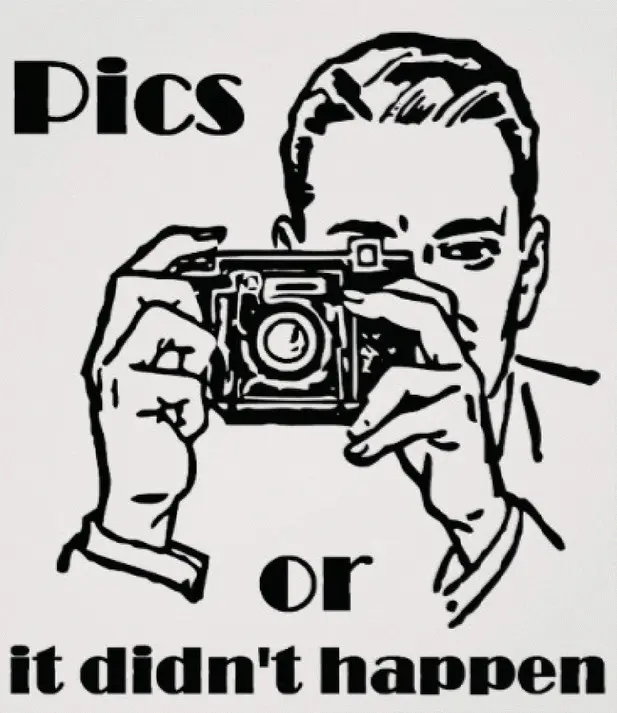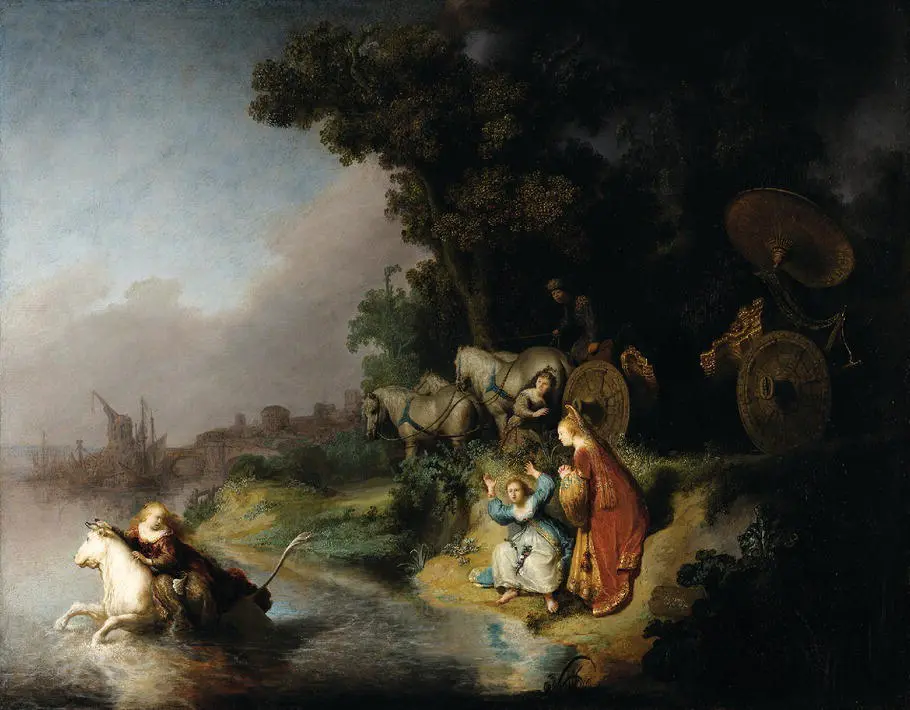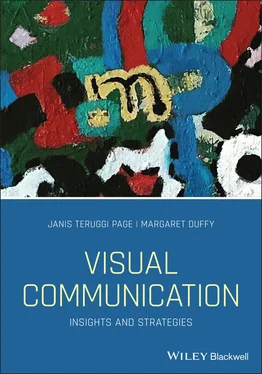PART ONE Understanding Visual Communication
Chapter 1 Making Sense of Visual Culture: 1000 Words or One Simple Picture?
“Pics or it didn’t happen.”

Source: http://www.dpreview.com/forums/post/58791114. Reproduced with permission of RetroClipArt/Shutterstock.com.
By 2015, this phrase had morphed from a meme to a catchphrase that seemed to be everywhere. If a friend tweeted that she'd been cliff diving in Acapulco, you might respond with that phrase suggesting that perhaps she was being boastful without any evidence to back it up (Whitehead, 2015). If your gamer pal claimed to have reached level 60 in World of Warcraft, you might demand some proof.
Other phrases call on our desire to tap into what Whitehead and others have called “visual authority.” You've all heard that “seeing is believing” and heard people say, “I'll believe it when I see it with my own eyes.” And consider the famous Chinese proverb, “a picture is worth a thousand words.” Here's the thing: it's not Chinese, and it's not a proverb. In fact, it was likely the creation of ad man Fred Barnard 1 in the 1920s. As William Safire (1996) writes, Barnard, trying to increase his agency's business selling ads on railway cars, came up with the phrase. He had it translated into Chinese characters with the caption “Chinese Proverb: One Picture is Worth Ten Thousand Words” and it passed into popular culture as “one thousand words.” Whether it is one thousand or ten, Barnard tapped into the notion that most people find visual evidence more credible and interesting than verbal or textual expression (Graber, 1990).
In entertainment, politics, interpersonal interactions, and at work and at play, we're all consuming, evaluating, and creating visuals. Our culture is increasingly suffused with images aimed at selling us something, persuading us, informing us, entertaining us, and connecting us with others. Your skills and capabilities in communicating effectively and critically evaluating what's around you are crucial to your personal and professional success and that is what this book is about. In the following chapters, we'll provide you with the tools to become an ethical and effective communicator in an era increasingly suffused with images of all kinds.
Key Learning Objectives
1 Understand visual culture and its transformation in the digital age.
2 Explore the fluidity of visual meaning.
3 Identify ways to research and analyze visuals.
Chapter Overview
In this introductory chapter, you'll explore five important issues relating to visuals in contemporary society. First, you'll be introduced to how visuals work and how we interpret them. Second, we'll review the astounding growth of visuals and video in recent years and how this trend is on a steep upward trajectory. Third, we examine the concept of visual culture and how changing technology relates to that culture. Fourth, you'll delve into how individuals can draw different meanings from the same visuals or video artifacts and how that process relates to social life and the meanings we take from our environment. Fifth, we preview ways to analyze visuals. At the close of the chapter we offer two vignettes illustrating how visuals work and provide an overview of the book as a whole.
LO1Understand visual culture and its transformation in the digital age
Today almost every part of our lives is visual and visualized. We routinely use devices to see, to capture experiences, and to communicate. As suggested by Tavin (2009), visual culture is “a condition in which human experience is profoundly affected by images, new technologies for looking, and various practices of seeing, showing, and picturing” (p. 3, 4). We are now at a place of unlimited visual culture and thus how we understand media and visual literacy has changed.
Among the things that strike us about images and photographs in particular is how they feel as if they are presenting us with a truth about reality. Sturken and Cartwright (2009) call this the “myth of photographic truth” (p. 24) because it obscures the roles of human beings who are creating the image. Those acts of creation include many factors such as the choices the photographer makes about the scene, lighting, and composition. Indeed, the photographer decides what subjects are worthy of their time or attention.
Even with technologies that make it easy and inexpensive to capture images of all kinds, the picture‐taker must choose those subjects, whether they are powerful images of war or funny pictures of grumpy cats. All of these will affect the tone of a photo and thus the interpretations people take away from it. Even though we may know intellectually that the photographer has chosen a certain subject at a certain time and framed it a certain way, a photo still carries a sense of legitimacy. Put differently, it involves the “legacy of objectivity that clings to the cameras and machines that produce images today” (Sturken and Cartwright, 2009, p. 18).
FOCUS: A Historical Perspective on Visual Culture
Another way to understand visual culture is to look at it historically. This example illustrates the role of perspective. When we compare medieval paintings (1300–1500) to contemporary paintings, we see remarkable differences. People in today's societies are used to seeing two‐dimensional (flat surfaces) that depict three‐dimensional spaces such as a road receding into the distance. In medieval times, Christianity was the primary organizing principle of society and artists presented religious and historical images based on the importance of those portrayed rather than more realistic representations (Willard n.d.). The world depicted in the paintings was the domain of God, not the lived experience of people, as shown in this two‐dimensional artwork from 1295 depicting the Twelve Apostles receiving inspiration from the Holy Spirit:

Source: Art Collection 2/Alamy Stock Photo.
In fact, it's thought that the highly religious yet illiterate people in medieval times would have found 3D representations to be puzzling and even heretical. The Renaissance in the late fifteenth century led to the emergence of interest in science, intellectual pursuits, and the more realistic depictions of the world. With this societal change, artists began achieving three‐dimensional effects using a whole range of techniques including linear perspectives, in which the “illusion that objects appear to grow smaller and converge toward a ‘vanishing point’ at the horizon line” (Jirousek, 1995). This is illustrated in Rembrandt's 1632 painting, The Abduction of Europa :

Source: GL Archive/Alamy Stock Photo.
Growing Importance of Visuals
Increasingly, visuals dominate how we communicate and how we understand other people, our society, and the culture in which we live. The line between the media we consume and what we used to consider “real life” is largely erased. Media are our environment as much as the physical spaces we inhabit. Old ways of belief are challenged even more in a world built of visual communication. According to Anderson (1990), this is resulting in an “unregulated marketplace of realities in which all manner of belief systems are offered for public consumption” (p. 6).
Читать дальше















